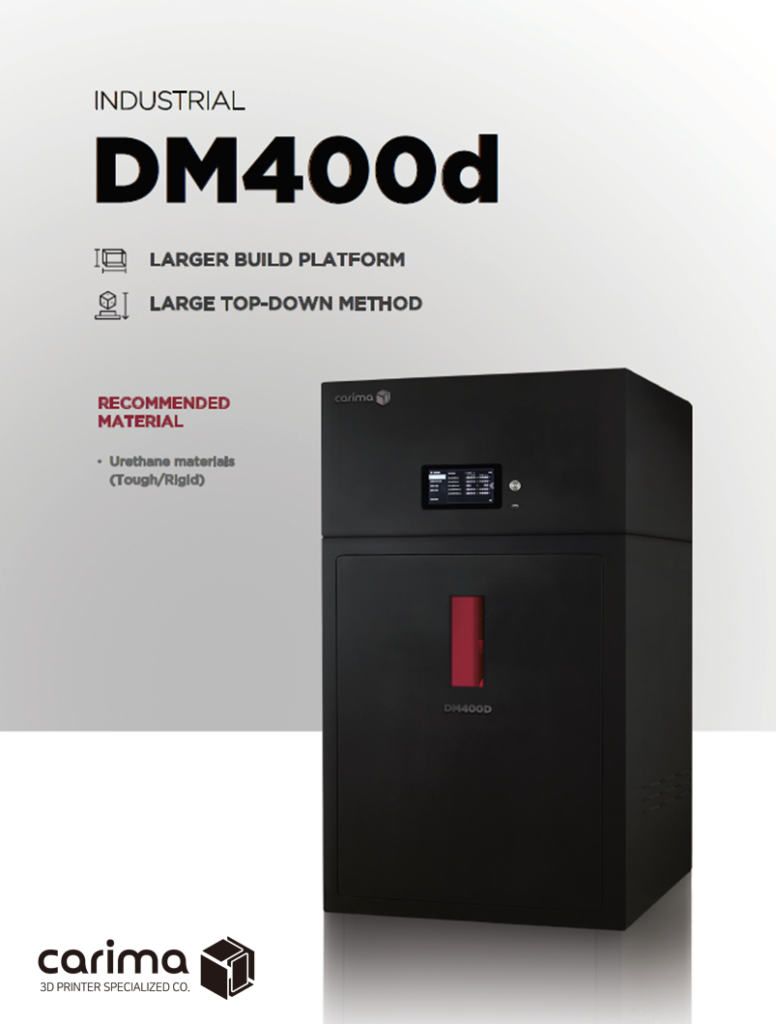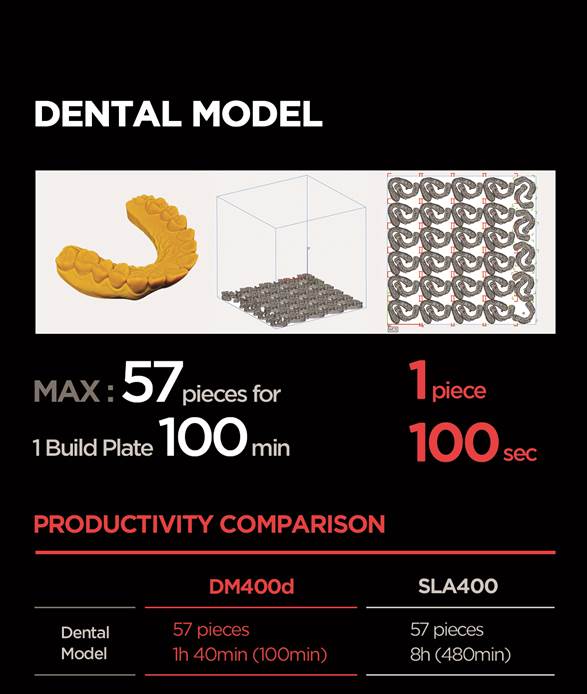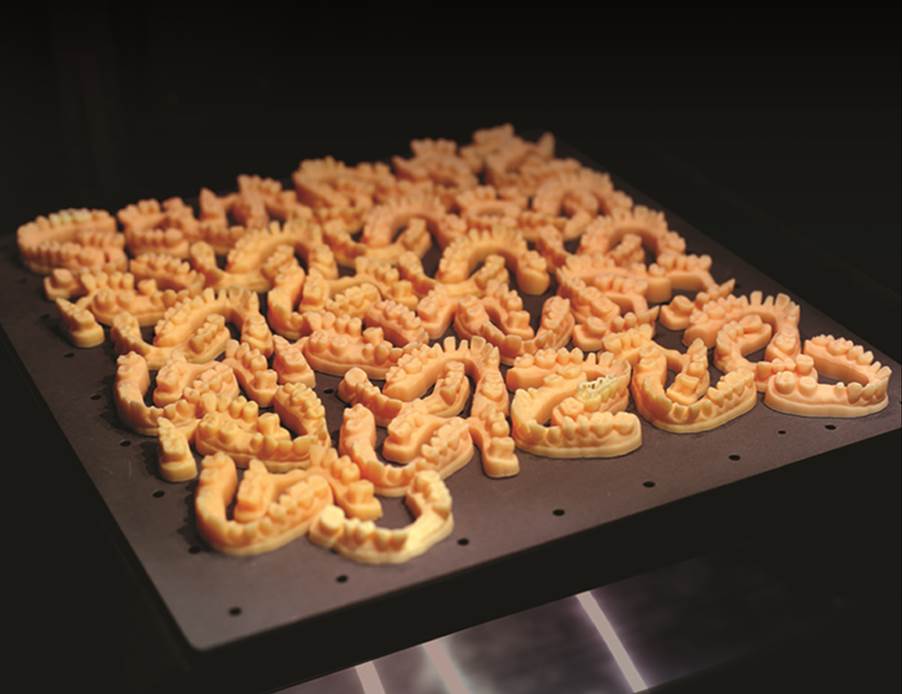Carima is continuing its mission to reach into every vertical with its ultra-quick C-CAT DLP technology. Though C-CAT, short for Carima Continuous Additive 3D Printing Technology, demonstrated its 1 cm per minute speed way back in 2015, the Korean 3D printer manufacturer has since been in the process of expanding both its market footprint and the footprint of its machines.
 The latest system, the DM400d DLP 3D printer, has an impressive build volume of 400 x 400 x 400mm while maintaining a precision of 100μm precision in the X/Y axes. Carima is targeting the printer at the dental market, billing it as a mass production machine capable of 3D printing 57 dental models in just 100 minutes.
The latest system, the DM400d DLP 3D printer, has an impressive build volume of 400 x 400 x 400mm while maintaining a precision of 100μm precision in the X/Y axes. Carima is targeting the printer at the dental market, billing it as a mass production machine capable of 3D printing 57 dental models in just 100 minutes.
Whereas DLP has traditionally boasted greater speeds over SLA, due to the ability to cure entire layers of photopolymer resin at a time, large-scale DLP is somewhat rare because of the need to maintain high resolution while projecting light on a large vat of resin. You can imagine how the image from a projector would become increasingly blurry at the edges as the scale of the image is increased. Carima claims to have solved that issue with the DM400d (for others that have tackled it, you might look to Prodways). As a result, the system offers five times the productivity of an SLA printer, according to the company.
To make this possible, the DM400 features dual 4K ultra HD UV LED engines curing multiple planes of the print area at once. All the while, the system is meant to maintain precise measurement, correcting for errors, thus maintaining stability and optical uniformity of over 99 percent across the entire build area. Carima’s internal testing demonstrated that in the 100 minutes it took an SLA printer to fabricate 11.5 units, the DM400d could make 57.
Due to the printer’s good surface finish and precision, Carima is targeting the DM400d at the medical and dental industries, but it is not limited to using specialty dental resins and can print with high-strength, distortion engineering materials for industrial applications, such as jigs, fixtures and replacement parts. The company also suggests that it will continue to develop specialty materials for use with the system. The use of a replaceable resin tank can increase production efficiency, as users can swap out the tank to clean it while the printer continues working with a new vat of material.

The latest release from Carima demonstrates not only an important development for the company, but for the medical and dental industries, as well. As we have learned from previous stories, the firm is also in the business of 3D printing custom ocular prosthetics and even spun out an entire bioprinting company called 3DKare. This is in addition to its wider range of DLP 3D printers for the jewelry sector and other industries.

As for the larger medical and dental industries, we know that 3D Systems, for instance, first targeted its Figure 4 platform at the dental market as it makes that platform more advanced and offers an increasing number of modules for mass production automation. We might then suspect that mass customization, which has already proven itself with invisible aligners and hearing aids, will continue to disrupt the medical and dental industries as it grows across the larger world of manufacturing.
If you happen to be at Formnext 2019, you’ll be able to check out the DM400d in person. To showcase the technology, among a range of other printers, Carima will be in Hall 12.1 No. G39.
Discuss this and other 3D printing topics at 3DPrintBoard.com or share your thoughts below.
Subscribe to Our Email Newsletter
Stay up-to-date on all the latest news from the 3D printing industry and receive information and offers from third party vendors.
Print Services
Upload your 3D Models and get them printed quickly and efficiently.
You May Also Like
Heating Up: 3D Systems’ Scott Green Discusses 3D Printing’s Potential in the Data Center Industry
The relentless rise of NVIDIA, the steadily increasing pledges of major private and public investments in national infrastructure projects around the world, and the general cultural obsession with AI have...
3DPOD 260: John Hart on VulcanForms, MIT, Desktop Metal and More
John Hart is a Professor at MIT; he´s also the director of the Laboratory for Manufacturing and Productivity as well as the director of the Center for Advanced Production Technologies....
Etsy Design Rule Change Reduces Selection of 3D Printed Goods
Online marketplace Etsy has implemented a rule change requiring all 3D printed goods on the site to be original designs. The update to the site’s Creativity Standards states, ¨Items produced using...
E-Beam OEM Wayland Additive Partners with USC Racing to 3D Print Titanium Exhaust Collector
Every year, standards organization SAE International holds a competition called Formula SAE, in which students from both undergraduate and graduate programs design, build, and race small formula-style race cars. For...

































